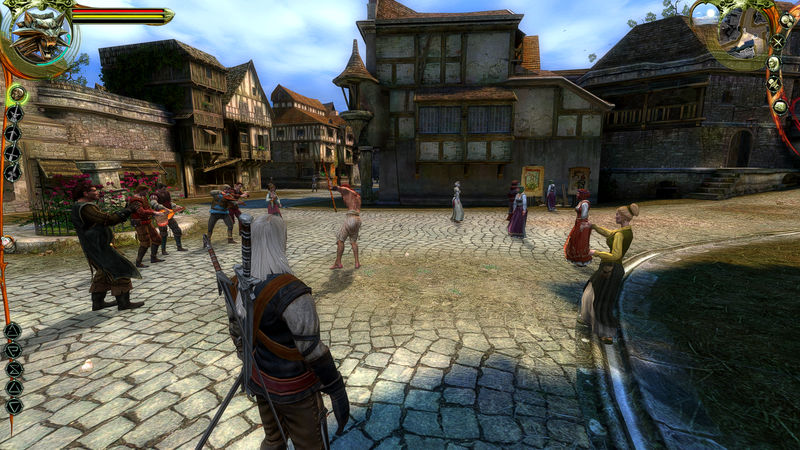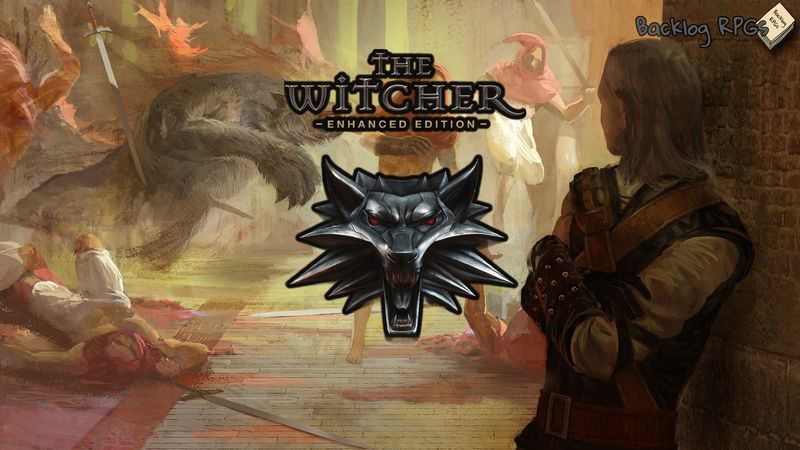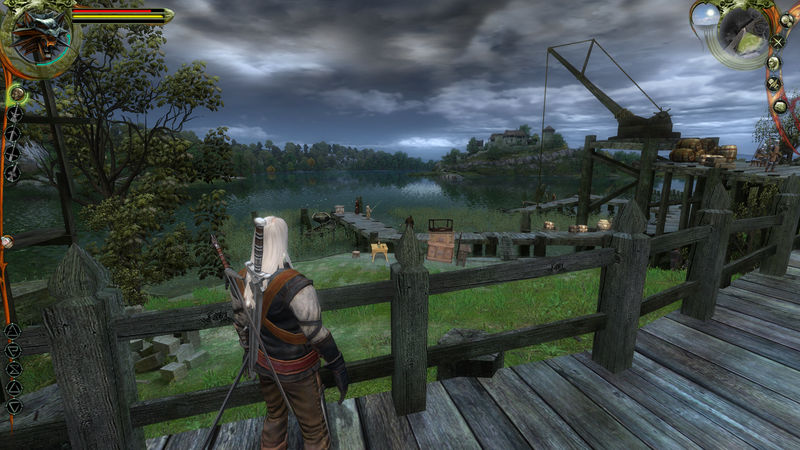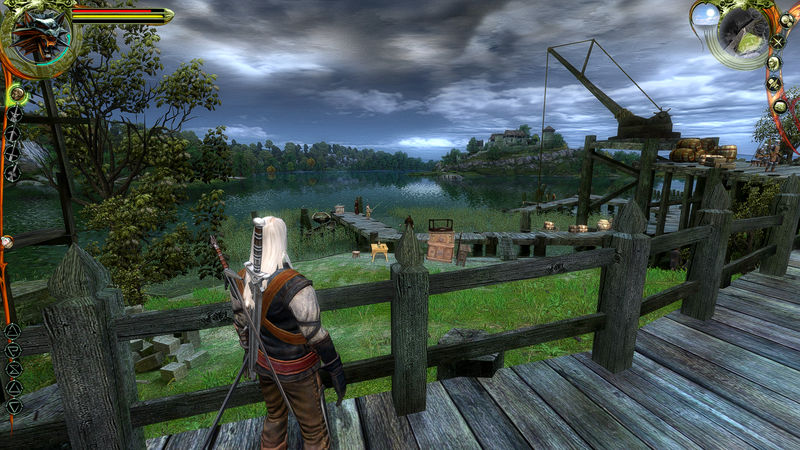In hindsight, it’s easy to think about 2007 as one of gaming’s greatest years, thanks to titles like Bioshock, Assassin’s Creed, Mass Effect, Portal, Mario Galaxy, Uncharted, Halo 3 and many others. It was a rough year for developers, who had to fight for the consumers’ attention. Amidst all these great releases, CD Projekt Red, at the time an unknown Polish company that only worked on translating games, released their very first title, The Witcher. Nowadays the franchise is widely known even by the general public, but for a lot of people this game was their first contact with the series.
The Witcher is an RPG originally released in October 2007, exclusively for PCs. It was inspired by The Witcher novels written by Polish author Andrzej Sapkowski. With “inspired” I meant that the game isn’t a straight adaptation of the books, but functions as a sequel to their story. It’s not mandatory to read the books to enjoy the game, as necessary information is always given to the player. But it’s neat to understand references to past events and to meet memorable characters from the novels.
The game saw a rerelease in September 2008, as The Witcher Enhanced Edition. It featured a lot of fixes for bugs, loading times, animations, etc. It also came with a lot of collectible goods, like a map, a strategy guide, a making-of DVD, and the game’s soundtrack. This is the version being sold on digital stores nowadays. But let’s talk about the game’s content.
The Narrative
Like the novels, The Witcher’s main character is Gerald of Rivia, an old, seasoned witcher. So, what is a witcher? To make matters simple, they are former humans artificially mutated to have superhuman reflexes, strength, speed, the capacity to see in the dark and a few other quirks. They kill evil creatures, lift curses and other similar activities for a fee.
The game is unnecessary divided in seven parts (a prologue, five chapters and an epilogue), since it’s just a long, self-contained story. Most chapters bring a change of scenario, moving Gerald alongside backward villages, a swamp and the city of Vizima.
As the game begins, Gerald’s friends find him confused and suffering from amnesia, after being presumably dead. Concerned, the other witchers bring him to their castle. During Gerald’s recovery, the game’s main antagonist, an organization called Salamandra, attacks the place, seeking out the mutagens used to create new witchers. The criminal group successfully steals them and it’s members flee through a portal.

Thanks to this event, now Gerald must depart to recover the mutagens, discover the evil organization’s true objectives and find out who he is. On this journey he will find some political intrigue, ethical dilemmas and some quirky characters.
As said before, the game is not an adaptation of the book series, but their sequel, as it begins a few years after the series last book, The Lady of the Lake. This was a clever idea since the developers didn’t become restricted by the books’ events.
As Gerald is the only playable character, the game focus heavily on his experiences, personality and viewpoint, always trying to explore the differences and similarities between his past self, as remembered by his old acquaintances, and the person he’s now, made by the player’s choices and actions. That was an ingenious way to justify why a seasoned fighter must relearn the basics of sword-fighting and regain all his previous knowledge. It also makes characters reintroducing themselves less awkward.
Overall, the game’s plot is very interesting and has a good length, offering many hours of gameplay even if you don’t do a lot of side quests. I spent a bit more than 60 hours, but I did many side quests — including collectathons — and explored a lot. Unfortunately, right at the end the story becomes too convoluted and devolves into a “we must save the world” kind of plot. Even if that was very disappointing, the game’s writing still is good, dealing with philosophical themes such as the nature of good and evil, the relativity of right and wrong, and prejudice.

Taking in consideration how morality is important to the game’s plot and story, it comes as a surprise that there is no real morality system, a standard feature at the time. I see it as a positive aspect because instead of restricting the player into being good or evil, The Witcher only offers different paths based on your stance on the ethical dilemmas presented through the game. You’re not judged by the developers, you just move some parts of the story into a specific direction. But your decisions won’t cause a significant shift to the plot. Someone lives and someone else dies, one person will help you or will try to kill you.
The game isn’t always serious, as it has a decent amount of humorous moments. One of my favorites is when a druid talks about protesting against animal cruelty (if I remember correctly, this joke was on one of the books also).
Most side characters will offer interesting dialogues about philosophical themes or just funny banter to lighten the mood. Together with other NPCs they give a lively appearance to cities and villages. Some NPCs will offer to waste your time playing games like fighting in the inn, drinking in the inn or playing dices in the inn. Unfortunately, there isn’t a lot to see or do outside the city of Vizima, making the outdoor environments feel somewhat empty.
You can also spice your playtime by “romancing” some ladies. After spending some quality time with them, you will earn a card with some beautiful artwork of your lover, very reminiscent of European comic books. Gotta catch ’em all, right? Interestingly, because the illustrations had some nudity were very provocative, the editions released in North America were censored had tamer drawings on the cards. Think about the children.
Mechanics
Even though the plot, dialogue and setting are good, The Witcher is not a book to be judged only by these elements. It’s a game, so its mechanics play an important role on judging its quality, even if it’s an RPG. It’s this aspect that pulls it down.
The game has an interface that is reminiscent of old CRPGs from the 90s. Like in those old titles, sometimes the game feels a bit clunky, mainly when you have a lot of dead enemies and need to search their corpses for new items. Also, managing the inventory can become a chore. You will develop carpal tunnel syndrome if you only use the mouse to play, so please learn the keyboard commands.
There are two main mechanics: a crafting system and the battle system.
Alchemy: the crafting system
Through Alchemy you can craft potions, blade coats and bombs. Potions have many different effects like healing, attack bonuses or seeing in the dark; blade coats make swords deal more damage; bombs cause damage or a negative condition to an enemy, like blindness or bleeding. To craft items, it’s necessary to acquire the item’s recipe and have the right ingredients on your inventory. It’s possible to acquire materials by skinning monsters, collecting herbs and by looking on places developers like to hide items (barrels, furniture, NPCs, etc.).
Alchemy is a useful addition because instead of resorting to grinding levels, the player can always give the enemies a negative status, increase Gerald’s attributes, exploit weaknesses or just throw a bomb to cause damage. It’s fulfilling to win against stronger opponents just by efficiently planning a fight. However, the more your level grows, the less useful this mechanic becomes, since opponents will stop to be a threat. There is no need to keep crafting items that will give you an advantage, just attack the enemy until it’s dead. Ultimately, Alchemy is a powerful tool that later becomes an afterthought.
Less importantly, it is also possible to craft armor and swords by visiting blacksmiths. Unfortunately, it isn’t necessary or helpful since most of these items are available from merchants, are given as part of the main story or are dropped by enemies.
The Battle System
The Witcher has a real-time battle system that probably looked very good on paper, but the longer you play the more it feels without depth, repetitive, slow and tiresome.

You can attack, cast magic or use support and offensive items. There are no defensive commands or movements. Like on The Witcher books, Gerald has two swords: a metal one for human, elves and dwarfs, and one made of silver for monsters. If the wrong sword is used, Gerald will deal less damage to the enemy. For each sword there are three attack styles: Strong for bigger or armored guys, Fast for smaller or fast opponents, and Group when you need crowd control. By clicking at the right time on the enemy, attacks of the same type can be chained in longer sequences.
There are also two special attacks, Special Blows and Coups de Grace. After a few upgrades, the player gains the ability to use Special Blows, which are stronger strikes executed by holding the attack mouse button until a bar fills up. But there is a drawback: these attacks drain endurance from Gerald. Coups the Grace are instant killing moves that are only useable against stunned or knocked down enemies.

Initially, it’s fun to watch Gerald’s moves, but after some hours of compulsive mouse-clicking it becomes uninteresting, even tedious to click and observe the long animations when you need to fight unimportant battles. It’s also frustrating when an attack doesn’t complete because there is no space for the attack sequence to complete. It’s also hard to fight using the over-the-shoulder camera, since some enemies like to attack you from behind. In the end I mostly used stun attacks in order to deliver Coup de Graces to quickly finish fights.
Presentation
Graphically the game is fine compared to other games from 2007, even if some character models are very ugly.
I replayed some parts of the game with the mod “StixsworldHD’s HD-4K Experience” by StixsmasterHD. It uses ReShade and makes the graphics shine, as if someone lifted a fog from your eyes. If you look around, there are other mods for graphical upgrades, with new textures and character models to make it more visually appealing if that is a problem for you.
The soundtrack is very atmospheric and fits the game’s tone and setting well, but I probably wouldn’t listen to it outside of the game. For those who enjoyed it more than I, a bit of bad news. When CD Projekt Red officially released it, they thought it was better to give us just 29 songs that actually are on the game and other 15 songs “inspired” by them, instead of releasing a full soundtrack. What a letdown.
Final Thoughts
On the storytelling front, The Witcher is a fine adaptation as it retains the book’s tone, colorful characters and some unusual moments. Unfortunately, even if its main storyline will keep you interested in its twists and turns, gameplay wise it isn’t very good due to its tiresome combat, some repetitive side quests and clunky interface. The game typically is very stable, and the worst bugs I found were related to events that didn’t trigger correctly. Loading from a previous save resolved the problem.
Taking in consideration its usual price and how cheap it becomes during sales, if you can put up with the game’s problems The Witcher is a worthwhile experience even if you aren’t one of Gerald’s fans.
Final opinion: Recommended for the franchise fans and for non-fans that can stand a tedious battle system to enjoy a good story.





